What's the difference between kayaking and canoeing? Let's find out!
Let's find out what's the difference between kayaking and canoeing.
There are some big differences and this page will show you.
It's important to know so you can make a choice as to which one you like best.
To start, here's the definitions of kayaking and canoeing.
What is canoeing?
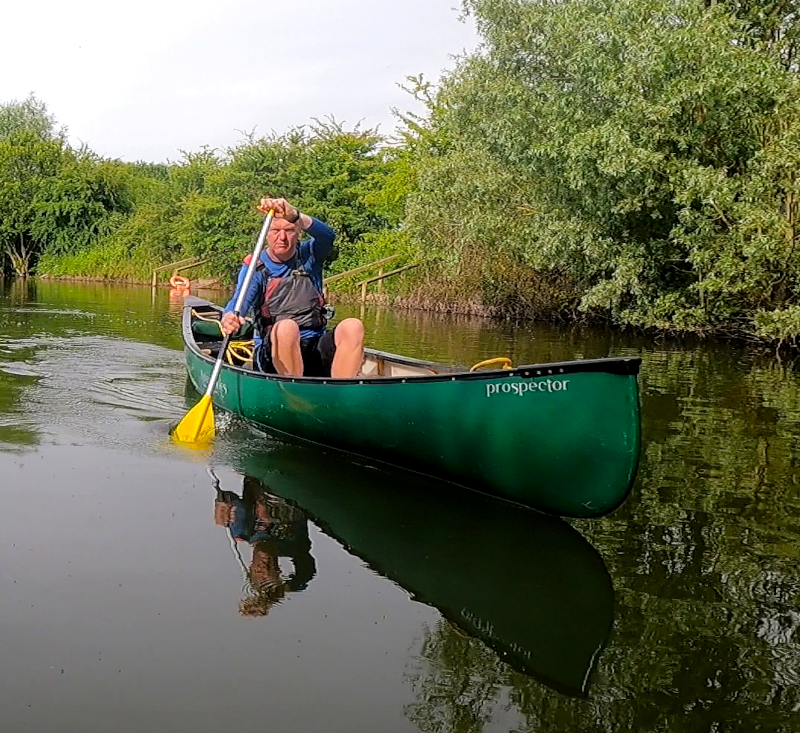 Dave paddling a canoe on a lake
Dave paddling a canoe on a lakeCanoeing is a physical activity that takes place in an open top boat called a canoe.
Canoes are often made from wood, carbon kevlar or derivatives of plastic to make them strong.
The canoe is propelled using a single paddle blade. A canoe can be operated by one person - sitting or kneeling in the middle of the canoe, but is commonly operated with two people - one at the front and one at the back.
What is kayaking?
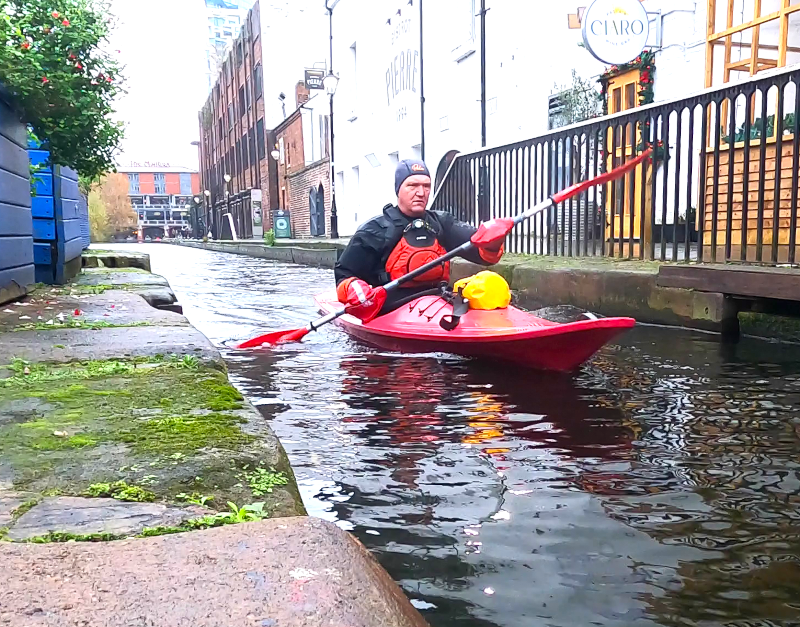 Dave paddling a kayak through Birmingham
Dave paddling a kayak through BirminghamKayaking is a physical activity that takes place in a usually closed top boat called a kayak. The kayak can be made of wood, fibreglass, carbon kevlar or plastic.
The kayak is propelled using a double paddle blade. A kayak can be operated by more than one person (called a K2 or K4), but is more commonly operated with one person. They sit in the middle of the kayak so it is balanced front to back.
Key differences between kayaking and canoeing
Here are the key differences between kayaks and canoes.
Overview of kayaks and canoes
Kayaks are available in a wide range of sizes, designs and materials. They can be tailored for flatwater right through to whitewater. There are specialist craft for flatwater, whitewater, slalom, polo and the sea.
Canoes have a smaller range of sizes and materials and generally follow a standard design. There can be tailored to flatwater or whitewater and this is much easier to do than with a kayak. Because the basic craft stays the same, it means only the outfitting (usually airbags) needs adding/changing to make it suitable for moderate whitewater.
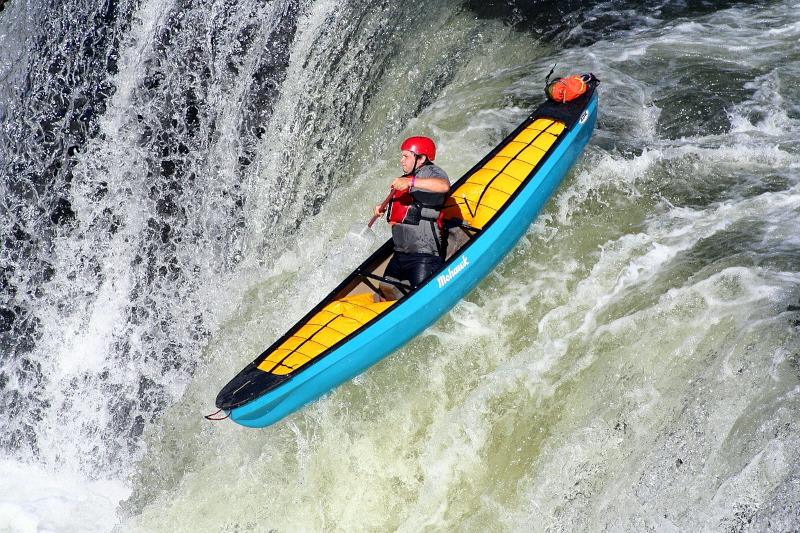 A paddler in a canoe on extreme whitewater. The extra airbags create buoyancy and
stop water filling the canoe. (c) Pixabay
A paddler in a canoe on extreme whitewater. The extra airbags create buoyancy and
stop water filling the canoe. (c) PixabayLengths of kayaks and canoes
Kayak length can vary from a couple of metres to over 4 metres for a sea or sprint kayak.
The shorter lengths are much easier to turn and more fun on whitewater. Longer kayaks make river, sea and lake trips much easier as they keep in a straight line.
Canoe lengths tend to start from 3.5 metres through to 5 metres. Again, shorter canoes are easier to turn and suitable for a single paddler and longer canoes ideal for river or lake trips with two or even three paddlers.
Materials for kayaks and canoes
The material kayaks and canoes are made from has a direct impact on how strong they are and how much they weigh.
Strong materials like plastic can be used to make canoes and kayaks but generally these will be on the heavier side.
Carbon kevlar is strong for moderate impacts and creates a light kayak or canoe.
Wood is a traditional material for kayaks and canoes and results in a fantastic hand made finish. This material is a specialist material for kayaks and canoes and normally they would be made from plastic derivatives or carbon kevlar.
Weights of kayaks and canoes
The weight of the craft is really important. Lighter craft may perform better on the water and are easier to carry to and from the water.
Kayaks range in weight from around 10kg through to 30kg plus for large touring kayaks.
Canoes range in weight from around 15kg through to 35kg plus.
Unless ultralight, canoes are best carried by two people. Most kayaks can be shoulder carrried by one person (see this video 'Carrying your kayak - 3 ways, which one is easier?').
Layouts of kayaks and canoes
The shape of a kayak and canoe are similar. They have a front, the bow, and a back, the stern. They are wide enough to fit a least one person and generally look like a banana!
Some may be wider than others - which can provide a little more stability.
For kayaks, the cockpit (where you sit) is in the middle of the kayak - front to back.
Canoes have seats - one at the front and one towards the back. For use with a single paddler, you can sit in the middle of the canoe - front to back.
Designs of kayaks and canoes
They are many different designs available. Design in this context is the colour and/or graphics.
Canoes are available with very colourful and wild designs although they do tend to be a single colour and either blue, red, orange or green.
Kayaks, depending on the material they are made from, can also be colourful and wild with not just single colours, but blended colours and designs like below.
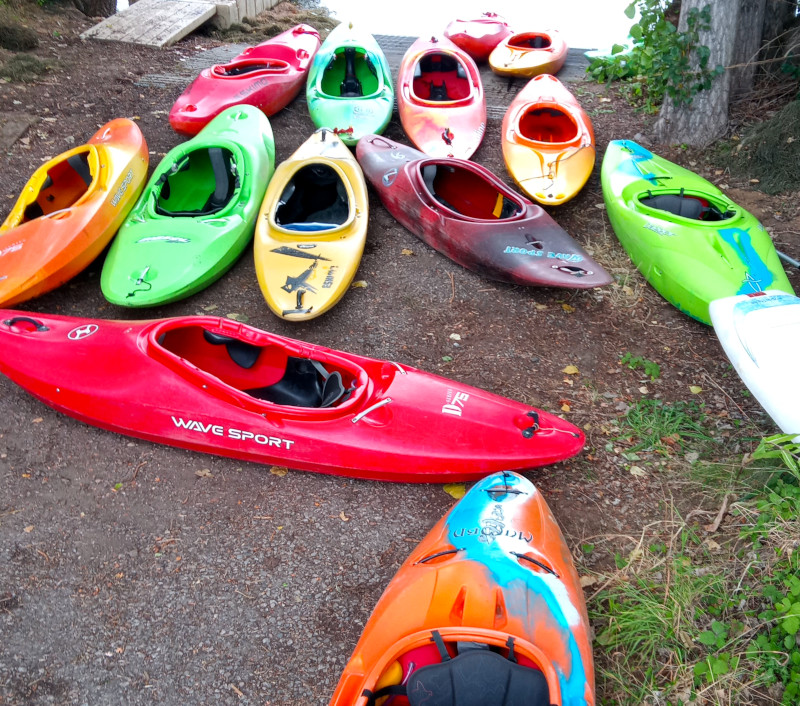 Kayaks showing the types of designs available - from single colours to blended designs
Kayaks showing the types of designs available - from single colours to blended designsStorage of kayaks and canoes
Because of their bigger size and weight, canoes tend to be more difficult to store. Ideally they should be stored upside down, off the ground and covered if possible (by hard or cloth/plastic material).
Lifting them high off the ground can be tricky so low level racking works better. If the canoe does need lifting above head height, then two or more people should be involved in the lift.
Kayaks are generally lighter and more suited to high level storage (eg. the eaves of a garage). Shorter kayaks can be stored on their ends vertically if strapped to avoid them falling.
Both crafts are suited to be stored out of direct sunlight and protected from harsh weather.
Performance of kayaks and canoes
Canoes tend to be slower and less manoeuvrable than kayaks.
Even with two people in, a canoe has extra weight which generally outweighs the power advantage of two people. Not always though!
Canoes can be taken on smaller whitewater once additional buoyancy and safety features have been added.
Kayaks designs can provide a very streamlined craft that is super efficient at going forwards fast. These would be used in kayak marathons and racing.
Other designs are more suited to fast pace and fast turns on whitewater and these would be used in kayak slalom.
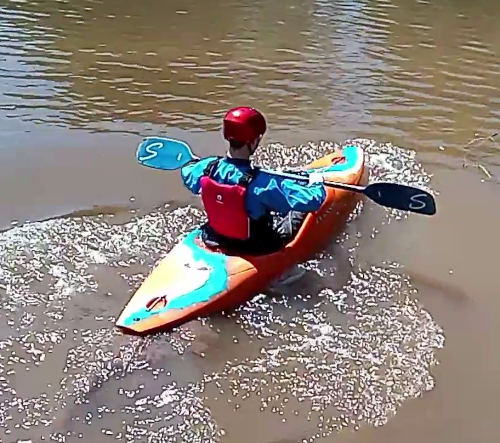 Ed paddling a whitewater playboat
Ed paddling a whitewater playboatSafety and rescue of kayak and canoes
Keeping safe is paramount when out in your kayak or canoe.
Kayaks have the added advantage of a closed cockpit which means water is kept out of the kayak. This allows the kayak to roll (turn over and, using the paddle, be righted by the paddler). This is called a self rescue and is invaluable especially on whitewater.
Canoes, on the other hand, generally fill with water when they tip over. This means you have to empty them and get back in. A skill which needs plenty of practice.
In canoes, extra safety equipment like buoyancy bags, safety lines, bilge pump and flares should be carried.
Prices of kayaks and canoes
Prices for kayaks and canoes vary widely.
Prices when new
Canoes can range of £700 through to over £2000 for a top of the range in a very light material.
Kayaks can range from £300 through to £1500 for a top of the range in a very light material.
Secondhand prices
Canoes can be found secondhand from £250 upwards.
Kayaks can be found secondhand from £100 upwards depending on design and material.
Secondhand is a great way of getting a craft and saving money. Do inspect it though and check out the seller.
Prices valid as of Feb 2025 but should be checked.
For more information about choosing a kayak:
PS. Paddlesports can be dangerous.
Read our safety disclaimer - here

New paddling inspiration, tip, trip or technique video EVERY week! Watch Ed, Dave and Moo on their kayaking, canoe and SUP adventures. It's all about having fun on the water. 169,000+ views, 100+ videos & 700+ subscribers so far! Click below to start watching:
Ed & Dave Kayaking Youtube Channel
WANT TO HELP US?
We really value your visit to us today. We run this website and our Youtube channel to provide paddling inspiration, tips, trip and technique content to you. We love being out on the water! If you enjoyed your visit, you can support us by using the links below:
Buy us something on our wish list
Thank you
NEED WEB HOSTING?
We recommend IONOS. Great service, technical support and stable hosting. Click the link below to find out more:
IONOS Web Hosting - RECOMMENDED!



